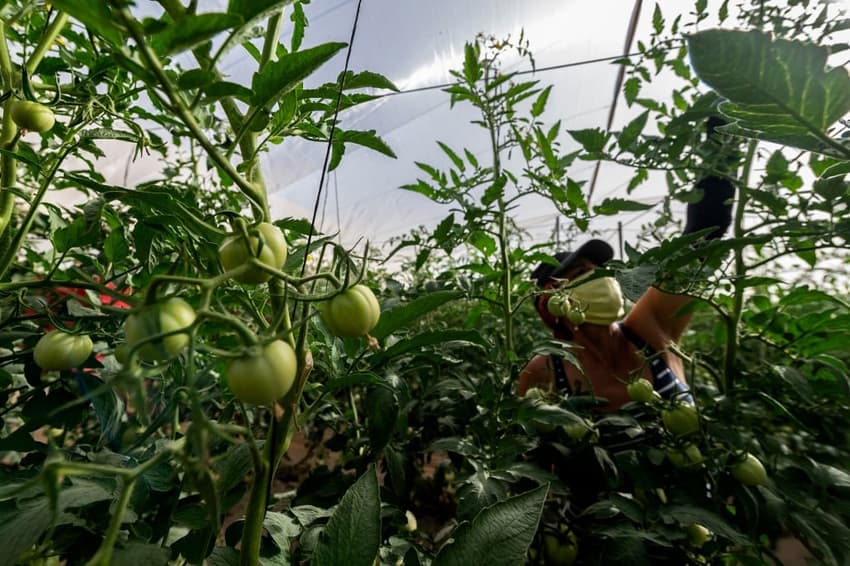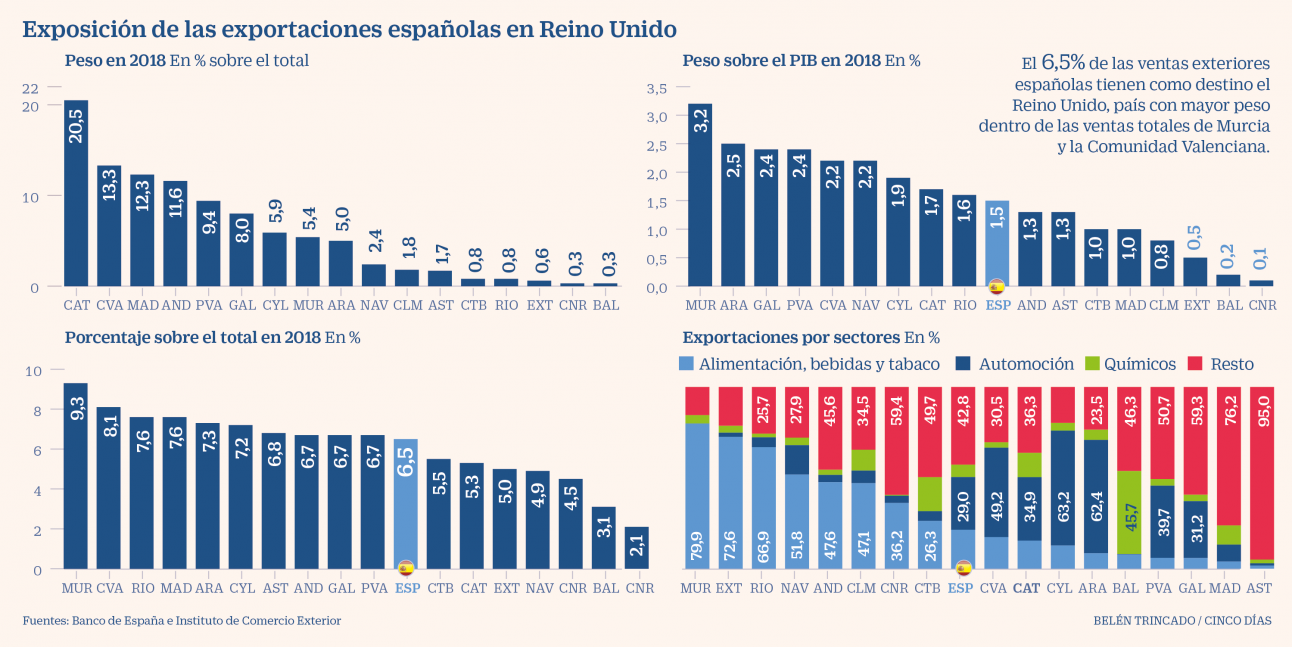Which parts of Spain would be most affected by a no-deal Brexit?

A new report by the Bank of Spain has highlighted the potential damage to Spanish exports if there is a failure to negotiate a trade deal with the EU-bloc by the end of 2020.
Britain officially left the European Union (EU) on Jan. 31, 2020, putting an end to its 47-year-long membership of the world's largest trading bloc. The remaining 27 EU member states have agreed to negotiate a trade deal with the UK by the end of 2020.
But with fewer than 100 days to go until the deadline, negotiations are in a quagmire.
If no deal is struck then the EU and UK would trade on World Trade Organization (WTO) terms -- bringing tariffs, and access to each other's markets reduced to an equal footing with all countries in the same situation.
So what could this mean for Spain?
The Spanish economy is already deep in recession thanks to the coronavirus pandemic with the government expected to revise its forecast for economic contraction this year to between 10 percent and 11 percent of GDP.
Add to this uncertainty over the future of trade with the UK, Spain’s fifth largest export destination which counts for 7 percent of Spanish exports, and there is real cause for concern.
The Bank of Spain has revealed the four regions of Spain that are the most exposed to the consequences; Murcia, Valencia, Galicia and Aragón.
This is due not just to the relative weight of their trade with the British market but also to their export specialization, as the highest tariffs are applied to the sectors of agriculture, textile and automative goods.
Asymmetrical effects

The report highlights that the effects of a hard trade Brexit would be asymmetrical across Spain’s regions. So although Catalonia, Madrid, Valencia and Andalucía are the regions with the highest sales quotas in the British market, that trade accounts for a lower percentage of the GDP.
READ MORE: No-deal Brexit 'would mean 70,410 job losses in Spain'
The report identifies that Murcia, Valencia, Galicia and Aragón would be the most potentially affected.

Exposure of Spanish exports in the UK in charts produced by Cinco Dias
Why is that?
Let’s look at Murcia where the exposure is twofold. Not only is it by far the most exposed region in relation to the size of its economy. In 2018, its exports to the UK represented 3 percent of GDP, double the national average of around 1.5 percent, and 9.3 percent of its total sales abroad go to the British market, compared to 7 percent of the Spanish average. But it also has a strong bias towards the agro-food sector.
The greatest exposure in the case of Valencia and Aragón derives from the weight of the automotive industry, while Galicia's export balance weighs towards its textile sector.
7 percent tariffs?
Until a trade deal is struck the tariffs are unknown but the report by the Bank of Spain uses the WTO rates to EU exports as a guide and calculates that "the average tariff for total Spanish exports to the UK will be just under 7 percent".
Taking into account that Spanish sales in the UK market have been close to €19 billion (compared to imports of around €11.4 billion euros), tariffs averaging 7percent would have an impact of around 1.3 billion in Spain.
READ MORE:
-
OPINION: Brexit causes yet more money worries for Brits in Spain
-
How post-Brexit bank changes could affect British people in Spain
-
'Brexit terms must be respected': EU's Barnier sends message to Boris Johnson
Comments
See Also
Britain officially left the European Union (EU) on Jan. 31, 2020, putting an end to its 47-year-long membership of the world's largest trading bloc. The remaining 27 EU member states have agreed to negotiate a trade deal with the UK by the end of 2020.
But with fewer than 100 days to go until the deadline, negotiations are in a quagmire.
If no deal is struck then the EU and UK would trade on World Trade Organization (WTO) terms -- bringing tariffs, and access to each other's markets reduced to an equal footing with all countries in the same situation.
So what could this mean for Spain?
The Spanish economy is already deep in recession thanks to the coronavirus pandemic with the government expected to revise its forecast for economic contraction this year to between 10 percent and 11 percent of GDP.
Add to this uncertainty over the future of trade with the UK, Spain’s fifth largest export destination which counts for 7 percent of Spanish exports, and there is real cause for concern.
The Bank of Spain has revealed the four regions of Spain that are the most exposed to the consequences; Murcia, Valencia, Galicia and Aragón.
This is due not just to the relative weight of their trade with the British market but also to their export specialization, as the highest tariffs are applied to the sectors of agriculture, textile and automative goods.
Asymmetrical effects

The report highlights that the effects of a hard trade Brexit would be asymmetrical across Spain’s regions. So although Catalonia, Madrid, Valencia and Andalucía are the regions with the highest sales quotas in the British market, that trade accounts for a lower percentage of the GDP.
READ MORE: No-deal Brexit 'would mean 70,410 job losses in Spain'
The report identifies that Murcia, Valencia, Galicia and Aragón would be the most potentially affected.

Exposure of Spanish exports in the UK in charts produced by Cinco Dias
Why is that?
Let’s look at Murcia where the exposure is twofold. Not only is it by far the most exposed region in relation to the size of its economy. In 2018, its exports to the UK represented 3 percent of GDP, double the national average of around 1.5 percent, and 9.3 percent of its total sales abroad go to the British market, compared to 7 percent of the Spanish average. But it also has a strong bias towards the agro-food sector.
The greatest exposure in the case of Valencia and Aragón derives from the weight of the automotive industry, while Galicia's export balance weighs towards its textile sector.
7 percent tariffs?
Until a trade deal is struck the tariffs are unknown but the report by the Bank of Spain uses the WTO rates to EU exports as a guide and calculates that "the average tariff for total Spanish exports to the UK will be just under 7 percent".
Taking into account that Spanish sales in the UK market have been close to €19 billion (compared to imports of around €11.4 billion euros), tariffs averaging 7percent would have an impact of around 1.3 billion in Spain.
READ MORE:
- OPINION: Brexit causes yet more money worries for Brits in Spain
- How post-Brexit bank changes could affect British people in Spain
- 'Brexit terms must be respected': EU's Barnier sends message to Boris Johnson
Join the conversation in our comments section below. Share your own views and experience and if you have a question or suggestion for our journalists then email us at [email protected].
Please keep comments civil, constructive and on topic – and make sure to read our terms of use before getting involved.
Please log in here to leave a comment.